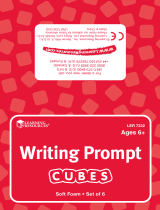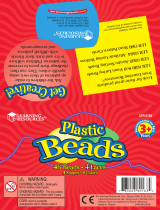
How Many Trains?
Give each group Snap Cubes
®
in two colors. Begin by snapping
one of each color Snap Cube together. Explain that this is a
two-car train because it is made with just two Snap Cubes. Ask
students to find other two-car trains. Students should find that
they can make four different two-car trains with their Snap
Cubes. For example, red-red, green-green, red-green, and
green-red. Point out that in this activity, two trains having the
same color cubes, but arranged in a different order, such as
the red-green trains, count as two different trains. Have
students trace the cubes to keep track of all of the trains
they are making.
Now, have students find all the three-car trains (trains that
are three cubes long) that can be made using no more than
two colors. Students will need to keep a record as they work
in order to have enough cubes to complete this activity.
About Snap Cubes
®
Snap Cubes are
3
⁄4-inch interlocking cubes that connect on every
side. They come in sets of 100, 500, and 1000, each containing
an equal amount of 10 different colors. A set of 100 cubes is
sufficient for four to six students.
Activities with Snap Cubes are suitable for children in all grade
levels. They help students learn about whole numbers
(counting, more and less, place value, addition, subtraction),
measurement, probability, graphing, and geometry. They are
ideal for exploring rhythmic patterns as well as growth
patterns, and for doing spatial reasoning tasks.
© Learning Resources, Inc., Vernon Hills, IL (U.S.A.)
Learning Resources Ltd., King’s Lynn, Norfolk (U.K.)
Please retain our address for future reference.
Made in China. LRM7584-GUD
Fabriqué en Chine. Informations à conserver.
Made in China. Bitte bewahren Sie unsere
Adresse für spätere
Nachfragen auf.
Hecho en China. Conservar estos datos.
For a dealer near you, call:
(847) 573-8400 (U.S. & Int’l)
(800) 222-3909 (U.S. & Canada)
+44 (0)1553 762276 (U.K. & Europe)
®
LER 7584

Free Exploration
Before using Snap Cubes
®
for formal activities, give students
time to play with them. By giving them time for such tinkering,
you’ll find students more willing to use Snap Cubes during
formal lessons later. After students have experimented with
Snap Cubes, ask them to talk about them. They might want to
show the class some of the figures they made and explain how
they created them.
Race for a Yard
This activity is for pairs of children. They will need a yardstick, a
die, and 100 Snap Cubes. Children take turns rolling the die,
and snapping together the number of cubes it indicates. The
goal is to be the first to make a train of cubes equal in length
to a yardstick.
Cubes That Grow
Give each pair of students 100 cubes. Introduce the word
“face” as another way to refer to a side. Point out that each
Snap Cube has 6 sides or faces. Ask students to explain the
meaning of “edges” and “vertices.” If these words are
unfamiliar to students, tell them the meanings and have them
locate the 6 faces, 8 vertices, and 12 edges.
Identify one Snap Cube as a 1x1x1, and ask students to make a
2x2x2. Tell students that they are to build several cubes; one
with two cubes on each side – 2x2x2; one with three cubes on
each side – 3x3x3; and, one with four cubes on each side –
4x4x4. Post on the chalkboard or overhead two questions for
students to answer:
• How many Snap Cubes are needed to build each cube?
• How many Snap Cubes are not visible from the outside?
Clarify by explaining that although all 8 Snap Cubes used to
make the 2x2x2 cube can be seen, for larger cubes, some
Snap Cubes will be inside and not visible. Encourage students
to continue making observations. Tell them, “Based on your
investigations of these cubes, do you see a pattern? What can
you predict for cubes larger than the ones you’ve built?”
Further Investigation
Present the following: “Suppose that I dipped the 2x2x2 cube
into a bucket of special paint so that as soon as I removed
the cube, it dried instantly. Then I took the cube apart. How
many Snap Cubes would have all their faces painted? How
many would have only three faces painted? Two painted?
One? None?”
Once most students see that every Snap Cube would be painted
on three sides, ask them what would happen if you dipped the
3x3x3 cube in the special paint. Allow students time to think
about this in their groups and then report back to the class.
Explain that they are to continue the investigation for dipping
larger cubes in this special paint, and record their findings on a
chart. Suggest that they look for patterns and use them to
make predictions. Ask students to write down the patterns they
find. Groups that finish early should compare their written
statements.
Creating Student Patterns
Give pairs of children a supply of Snap Cubes, crayons or
markers, and Snap Cube recording sheets containing 12 or
more
3
⁄4" squares, printed on sturdy cardboard. Ask each
student to make a pattern with the Snap Cubes and record it by
tracing the outlines on the recording sheet. Have partners
exchange their work. Direct them to check that the Snap Cube
pattern built matches the recording sheet and that it is labeled
correctly. Have students discuss any disagreements and make
corrections, if necessary.
/












